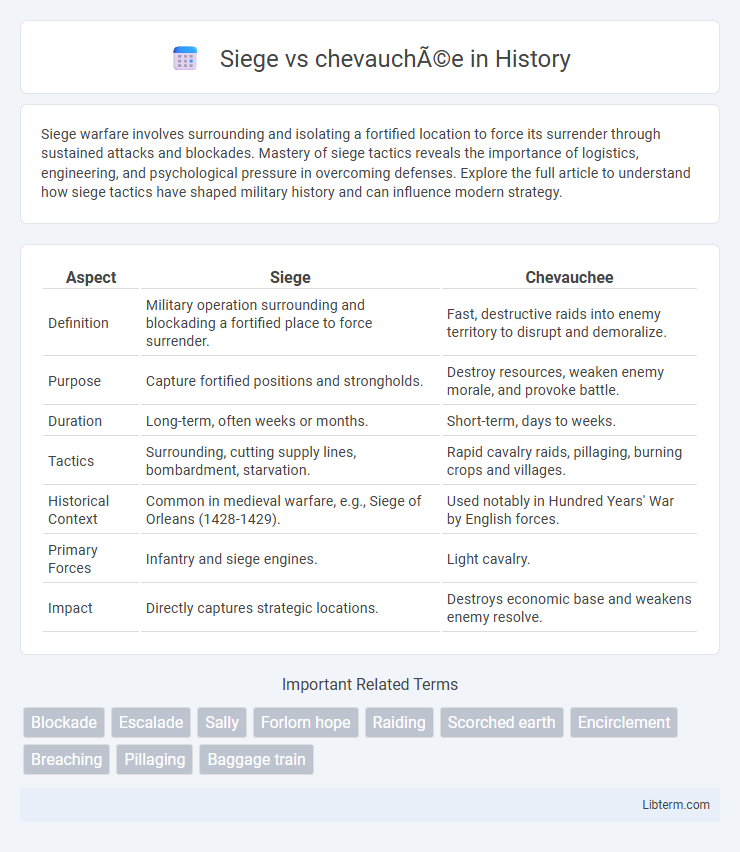Siege warfare involves surrounding and isolating a fortified location to force its surrender through sustained attacks and blockades. Mastery of siege tactics reveals the importance of logistics, engineering, and psychological pressure in overcoming defenses. Explore the full article to understand how siege tactics have shaped military history and can influence modern strategy.
Table of Comparison
| Aspect | Siege | Chevauchee |
|---|---|---|
| Definition | Military operation surrounding and blockading a fortified place to force surrender. | Fast, destructive raids into enemy territory to disrupt and demoralize. |
| Purpose | Capture fortified positions and strongholds. | Destroy resources, weaken enemy morale, and provoke battle. |
| Duration | Long-term, often weeks or months. | Short-term, days to weeks. |
| Tactics | Surrounding, cutting supply lines, bombardment, starvation. | Rapid cavalry raids, pillaging, burning crops and villages. |
| Historical Context | Common in medieval warfare, e.g., Siege of Orleans (1428-1429). | Used notably in Hundred Years' War by English forces. |
| Primary Forces | Infantry and siege engines. | Light cavalry. |
| Impact | Directly captures strategic locations. | Destroys economic base and weakens enemy resolve. |
Introduction: Defining Siege and Chevauchée
A siege is a military operation that involves surrounding and blockading a fortress or city to force its surrender through starvation, bombardment, or assault. Chevauchee refers to a fast-moving raid conducted by mounted troops aimed at devastating enemy territory, disrupting supply lines, and undermining morale without engaging in prolonged battles. Both tactics played crucial roles in medieval warfare, with sieges focusing on attrition and control, while chevauchees emphasized mobility and psychological impact.
Historical Origins of Siege Warfare
Siege warfare originated in ancient civilizations such as Mesopotamia and Egypt, where fortified cities necessitated prolonged blockades and assaults to breach defenses. Early techniques included building ramps, tunnels, and siege towers to overcome walls, evolving through periods like the Roman Empire with innovations such as ballistae and battering rams. Unlike the fast-moving chevauchee raids prominent in medieval Europe, siege tactics emphasized patience and engineering to capture strongholds strategically critical for territorial control.
The Chevauchée: Tactical Raiding Explained
The chevauchee is a rapid, mounted raiding tactic used mainly during the Hundred Years' War to disrupt enemy supply lines, damage infrastructure, and undermine morale. Unlike prolonged sieges, which focus on capturing fortified positions through blockade and assault, the chevauchee emphasizes speed, surprise, and mobility to inflict widespread economic damage. Commanders utilized this tactic to weaken opponents before major battles, avoiding direct confrontation while maximizing strategic psychological impact.
Strategic Objectives: Siege vs Chevauchée
Sieges aim to capture fortified positions by cutting off supplies and forcing surrender, focusing on attrition and control over key locations. Chevauchees prioritize rapid, destructive raids through enemy territory to undermine morale, disrupt logistics, and weaken economic resources without committing to prolonged engagements. Strategic objectives differ as sieges seek territorial gain through direct conquest, while chevauchees emphasize destabilization and resource depletion.
Key Differences in Execution
A siege involves surrounding and isolating a fortified location to force surrender through starvation, bombardment, or breach of defenses, emphasizing prolonged attrition and containment. In contrast, a chevauchee is a fast-moving raid deep into enemy territory, aimed at swift destruction of resources, supply lines, and morale without establishing control over defended positions. While sieges rely on static encirclement tactics demanding significant time and manpower, chevauchees prioritize speed, mobility, and disruption over direct confrontation.
Impact on Civilian Populations
Sieges typically caused severe suffering for civilian populations by cutting off food supplies, leading to starvation, disease, and prolonged hardship within fortified cities or castles. Chevauchee tactics deliberately targeted rural villages, farmland, and infrastructure, resulting in widespread destruction, displacement, and economic ruin for civilians in the affected regions. Both strategies inflicted significant trauma on civilian communities but differed in scope and duration of impact, shaping medieval warfare's humanitarian consequences.
Famous Sieges in Medieval History
Medieval sieges, such as the Siege of Jerusalem (1099) during the First Crusade and the Siege of Orleans (1428-1429) in the Hundred Years' War, showcased strategic warfare aiming to capture fortified cities through encirclement and starvation. Unlike chevauchees, which emphasized rapid cavalry raids to devastate enemy lands and weaken morale, sieges focused on prolonged blockades and use of trebuchets or battering rams to breach fortifications. Famous sieges exemplify intense military engineering and psychological warfare pivotal in reshaping medieval political landscapes.
Notable Chevauchées and Their Outcomes
Notable chevauchees such as the Black Prince's 1355 expedition in southwestern France inflicted widespread destruction, severely undermining French morale and economic stability without capturing major fortresses. The chevauchee led by Edward III in 1346 culminated in the Battle of Crecy, showcasing the effectiveness of long-range arrow fire and marking a pivotal English victory. These fast-moving raids prioritized crippling enemy resources and forcing battle over the prolonged, resource-intensive tactic of siege warfare.
Evolution of Warfare: Transition Between Strategies
Siege warfare evolved from prolonged encirclements aiming to starve defenders into more sophisticated methods incorporating artillery and engineering advancements, reflecting growing technological capabilities. Chevauchee represented a mobile, destructive strategy focused on rapid raids to disrupt supply lines and economies, emphasizing speed over direct confrontation. The transition between these strategies highlights the shift from static, resource-intensive campaigns to flexible, maneuver-oriented operations in medieval warfare.
Conclusion: Lasting Legacy on Medieval Military Tactics
Siege warfare revolutionized medieval military tactics by emphasizing fortified strongholds and prolonged attrition strategies, compelling armies to develop advanced engineering technologies and sustained supply logistics. Chevauchee campaigns, characterized by rapid, destructive raids, shaped tactics centered on mobility, psychological warfare, and disruption of enemy resources, influencing the strategic balance between offense and defense. Together, these approaches left a lasting legacy, integrating siegecraft and mounted raids into comprehensive medieval warfare doctrines that prioritized both endurance and agility.
Siege Infographic

 libterm.com
libterm.com